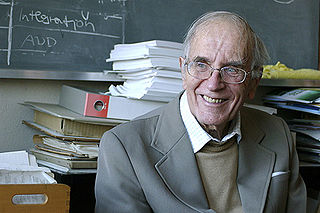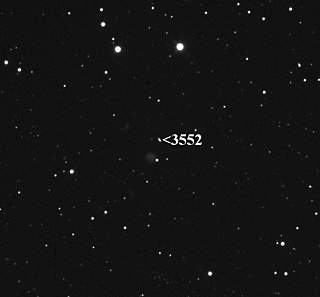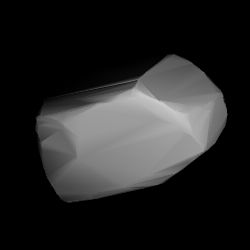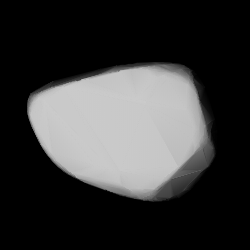
Paul Wild was a Swiss astronomer and director of the Astronomical Institute of the University of Bern, who discovered numerous comets, asteroids and supernovae.

3552 Don Quixote, provisionally designated 1983 SA, is an exceptionally eccentric asteroid, classified as a near-Earth object of the Amor group, Mars-crosser and Jupiter-crosser, as well as a weakly active comet.

2001 Einstein is a bright Hungaria asteroid from the innermost region of the asteroid belt. It was discovered by Swiss astronomer Paul Wild at Zimmerwald Observatory near Bern, Switzerland, on 5 March 1973. The X-type asteroid (Xe) has a rotation period of 5.5 hours and measures approximately 5 kilometers in diameter. It is named after physicist Albert Einstein (1879–1955).
1313 Berna, provisional designation 1933 QG, is a background asteroid and synchronous binary system from the Eunomian region in the central asteroid belt, approximately 14 kilometers in diameter. It was discovered on 24 August 1933, by Belgian astronomer Sylvain Arend at the Uccle Observatory in Belgium. The assumed S-type asteroid has a longer-than average rotation period of 25.5 hours and is likely elongated in shape. It was named for the Swiss capital of Bern. The discovery of an 11-kilometer-sized companion was announced in February 2004.
2368 Beltrovata, provisional designation 1977 RA, is an eccentric stony asteroid and near-Earth object of the Amor group, approximately 2.7 kilometers in diameter. It was discovered on 4 September 1977, by Swiss astronomer Paul Wild at Zimmerwald Observatory near Bern, Switzerland. The asteroid was named for Betty Tendering, a friend of author Gottfried Keller.
2038 Bistro, provisional designation 1973 WF, is a stony asteroid from the inner regions of the asteroid belt, approximately 12 kilometers in diameter. The asteroid was discovered on 24 November 1973, by Swiss astronomer Paul Wild at the Zimmerwald Observatory near Bern, Switzerland. It was named for the Bistro restaurant.

1961 Dufour is a large background asteroid, approximately 50 kilometers in diameter, located in the outer region of the asteroid belt. It was discovered on 19 November 1973, by Swiss astronomer Paul Wild at Zimmerwald Observatory near Bern, Switzerland, and later named for 19th-century Swiss General Henri Dufour.

1687 Glarona is a stony Themis asteroid approximately 34 kilometers in diameter from the outer region of the asteroid belt. It was discovered by Swiss astronomer Paul Wild at Zimmerwald Observatory near Bern, Switzerland, on 19 September 1965. It was later named after the Swiss Canton of Glarus.
2151 Hadwiger, provisional designation 1977 VX, is a Marian asteroid from the central region of the asteroid belt, approximately 15 kilometers in diameter. It was discovered on 3 November 1977, by Swiss astronomer Paul Wild at Zimmerwald Observatory near Bern, Switzerland.
1845 Helewalda is a carbonaceous Eoan asteroid in the outer regions of the asteroid belt, approximately 20 kilometers in diameter. It was discovered by Swiss astronomer Paul Wild at Zimmerwald Observatory near Bern, Switzerland, on 30 October 1972. The asteroid was named after Helen Gachnang, a friend of the discoverer.
2080 Jihlava, provisional designation 1976 DG, is a stony Flora asteroid from the inner regions of the asteroid belt, approximately 6 kilometers in diameter. The asteroid was discovered on 27 February 1976, by Swiss astronomer Paul Wild at Zimmerwald Observatory near Bern, Switzerland. It was named after the Czech city of Jihlava.
1938 Lausanna, provisional designation 1974 HC, is a stony Florian asteroid from the inner regions of the asteroid belt. It is approximately 8 kilometers in diameter, and was discovered on 19 April 1974 by Swiss astronomer, Paul Wild at Zimmerwald Observatory near Bern, Switzerland. It is named for the city of Lausanne.
1936 Lugano, provisional designation 1973 WD, is a carbonaceous Adeonian asteroid from the middle region of the asteroid belt, approximately 26 kilometers in diameter.
1748 Mauderli, provisional designation 1966 RA, is a dark and very reddish Hildian asteroid from the outermost region of the asteroid belt, approximately 45 kilometers in diameter.
1911 Schubart, provisional designation 1973 UD, is a dark Hildian asteroid and parent body of the Schubart family, located in the outermost region of the asteroid belt, approximately 70 kilometers in diameter. It was discovered on 25 October 1973, by Swiss astronomer Paul Wild at Zimmerwald Observatory, near Bern, Switzerland. The asteroid was named after German astronomer Joachim Schubart.
1941 Wild, provisional designation 1931 TN1, is an eccentric Hildian asteroid from the outermost region of the asteroid belt, approximately 20 kilometers in diameter.
1775 Zimmerwald, provisional designation 1969 JA, is a stony Eunomian asteroid and slow rotator from the middle region of the asteroid belt, approximately 10 kilometers in diameter. It was discovered on 13 May 1969, by Swiss astronomer Paul Wild at Zimmerwald Observatory near Bern, Switzerland. It is named for the village of Zimmerwald, where the discovering observatory is located.
2429 Schürer, provisional designation 1977 TZ, is a Maria asteroid from the central region of the asteroid belt, approximately 12 kilometers in diameter. It was discovered on 12 October 1977, by Swiss astronomer Paul Wild at Zimmerwald Observatory near Bern, Switzerland, and later named after Swiss astronomer Max Schürer. The likely elongated S-type asteroid has a rotation period of 6.6 hours.

63P/Wild is a periodic comet in the Solar System with a current orbital period of 13.21 years.
86P/Wild is a periodic comet in the Solar System with a current orbital period of 6.84 years. Its nucleus is estimated to have an effective radius of 0.37 ± 0.02 kilometers.







